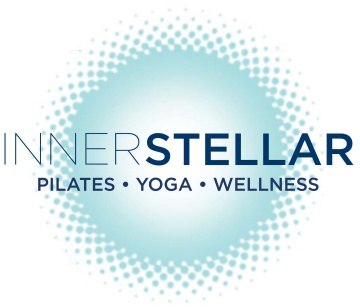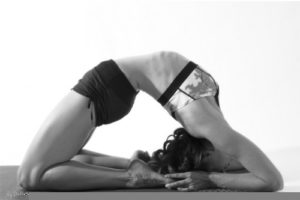Injury as Opportunity: How Yoga Can Heal Your Body, Mind & Spirit
By Erica Mather
People have been hurting themselves as long as humans have existed.
I am a particularly injury-prone specimen.
In elementary school, every time I went to gym, I sprained an ankle. Literally. This was so ongoing and consistent that eventually my pediatrician wrote me a doctor’s excuse from gym class, so long as I maintained regular exercise through swim team. I never went back to gym, and swam competitively through high school.
My brother joked that I could sprain an ankle tripping over a paint stripe. He made this joke, because it actually happened.
Never once did it occur to me to blame the paint stripe, walking, my shoes, my gym teacher, the Universe, the people around me. These things just happened.
However, there was a quiet voice in my head that suggested these things happened to me because I was somehow…disconnected, inattentive, unaware, checked out. I didn’t really know what to make of this idea, at the time.
Discussion in the yoga community is reaching fever pitch about how yoga can wreck your body.
The debate has raised hackles, frightened students, and elevated the visibility of some writers and teachers.
For years journalism has been tracing this theme, with articles I’ve found in Yoga Journal dating back to 1998. This discussion is not new.
Throughout it all I’ve wondered why so many have felt the need to defend yoga’s position as a physical form.
First, sometimes the best defense is no defense. Second, yoga is a technology for healing the spirit, the soul, and the emotions, by way of the body—its physical manifestation is at once immaterial and essential. Coming to yoga’s defense as a physical technology only more firmly entrenches it alongside forms of exercise, a trend that is happening all the more decisively all the time, and in my opinion is tragic.
Why does yoga potentially wreck your body? For so many reasons—allow me to list some of them:
1. Shit happens
2. You came to the practice without a sense of physical awareness in the first place, and over-did it
3. You came to the practice without some baseline fitness, and over-did it
4. You over-did it even though you possess a sense of awareness and fitness
5. Your teacher asked you to do something beyond your capability, and you didn’t or couldn’t discern this, and over-did it
6. You have a lifetime of injury, and something you did in class pushed past your edge
7. You were comparing yourself to the person next to you
8. You were comparing yourself to the teacher
9. You were thinking about something else while practicing, and hurt yourself
10. You weren’t breathing consciously
11. You were holding your breath
12. You were thinking about how great you look in the pose, and then over-did it
13. Shit happens
This entire list really tells you more about you than anything else. When you hurt yourself using a hammer, you don’t blame the hammer. When you hurt yourself using yoga, don’t blame yoga.
Injury, in any context, gives you an opportunity to look deeply into the situations in which you find yourself, and to learn from them.
Sometimes you have to look very, very deeply, in particular, when you have old history with an injury, and it may take a very long time to unfurl.
Let me tell you a story.
One of my original injuries is a right shoulder injury. I believe it began as far back as age eight when I first developed tendonitis from over-use in the pool. It was continually exacerbated through swimming as well as extensive piano practice—I played every day, and the right often gets more attention than does the left.
In middle school a “friend” yanked on my head while I was standing at my locker. I heard a crunch in my neck and felt pain in my upper back, but said nothing about it to anyone. As time passed, the pain from practicing the piano turned into a complete numbness in the right mid and upper back. In college I developed ulnar neurosis in my right arm and had to stop playing the piano for a period of time.
After college while at a desk job, my shoulders and neck were so tight that I forced my acromio-clavicular joint back into place with a hobble pop! that only created worse pain, and the need for some PT.
I don’t think I need to go on, right?
So, does it come as any surprise that eventually I began to have migraine headaches on the right side? Does it come as any surprise that eventually I made the decision to stop playing the piano, in part because it just hurt too much?
Cue yoga practice.
When I began having migraines, I started yoga, upon the recommendation of an ex-Navy Seal acupressurist.
At yoga, and specifically Forrest Yoga, I began to get the tools to heal my body, and also to trace back further into some of the psychological origins of these injuries that I sustained so very many years ago, and as a result to begin to mend the tears in the fabric of my spirit and emotions.
I began to see that the migraines’ onset were the tipping point in my life and in my body. There were just too many false-hoods happening in my life, and my body said “enough!”
Yoga gave me this awareness and sensitivity.
Just this past year (note the very late date!), I really felt for the first time what I had been doing to my neck and back, all those years of swimming: with each stroke I was anchoring into my body the conviction I had as a youth of being inadequate. Not fast enough, not slim enough, and therefore not the cool kid on the swim team.
Stroke, “not good enough.”
Stroke, “go faster.”
Stroke, “you’re too fat, that’s why you’re not faster.”
Stroke, “if you were faster, the other girls on the team would like you more.”
Stroke, “if you were faster, the boys on the team would like you more.”
Stroke, “you’ll never be good enough.”
Every. Day. Thousands of strokes.
Where did these thoughts go? Into my neck. Up, up, into my head.
When I realized this, I wept for the girl I was then, who felt these horrible emotions every single day and who burnt it into the cell tissue of her body in ways that poisoned her soul.
These tears were so cleansing, and just began to account for the years of tears unwept by that girl.
I wrecked my body. Not swimming. Not my coaches. Not the pool. I did it. I poisoned my soul. The responsibility is largely mine.
And yoga gave me the help to see this, and the help to heal and recover, in ways that doctors and medicine never will.
Are my migraines gone? No. But when doctors cannot tell me what they are, where they come from, or even why or how my medication works, I find it tremendously comforting and empowering to have the self-knowledge that I do.
Have I hurt myself at yoga—absolutely. Could I wreck my body—certainly. But, I could also doing this crossing the street, and yoga has given me tools to use wisely to do exactly the opposite.
I now consider my myriad of life injuries as opportunities to study myself, and how I work in the world. Some of them, like the one that I’ve recounted here, are legacies of the past with strong roots in who I am right now. Sometimes when I hurt myself, it shows me the ways that I disconnect in the present, in new ways. Injury keeps me on my toes.
Consider injury to be your opportunity to look deeply into yourself, using yoga as the lens.
Erica Mather is a lifelong teacher. Her life mission is to make a difference in the world, and, hopefully, in YOUR life.
Her many recent offerings include:
Forrest Yoga
Yoga Sequencing
Hands on Assists
Managing and Healing Injury
Life Planning
Body Image Positivity
In 2009 Ana Forrest invited Erica to become part of an elite circle of teachers, The Guardians, senior teachers who are entrusted with passing along the Forrest legacy.


